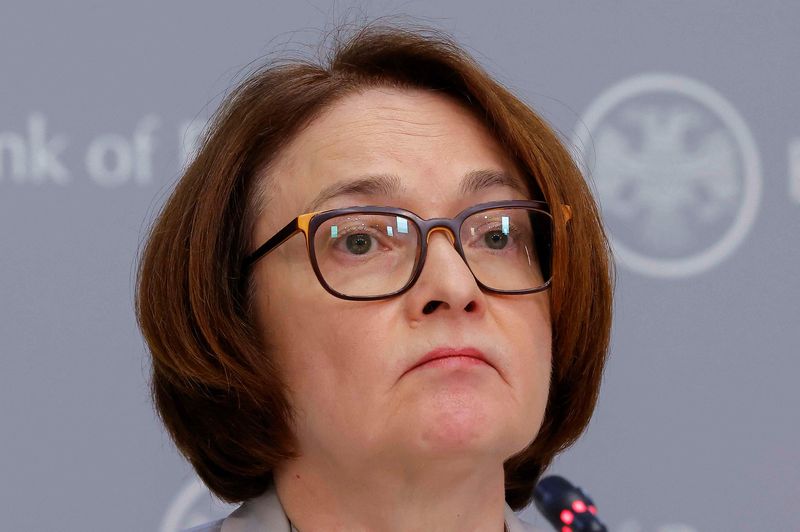Russia’s Nabiullina on raising rates to 21%
2024.10.25 09:46
MOSCOW (Reuters) -Russian Central Bank Governor Elvira Nabiullina and her deputy Alexei Zabotkin addressed a news conference on Friday after the central bank hiked its key rate to 21%, the highest level since February 2003.
Nabiullina spoke in Russian. The quotes below were translated into English by Reuters.
NABIULLINA ON THE RATE DECISION
“We considered three options today: to raise the rate to 20%, to 21% and above 21%. The option of holding the rate was not considered, no one suggested it, but we discussed the options of raising the rate to 20% and 21%.
“The possibility of raising the rate with the same steps in the next (meeting) will depend on the data that we’ll receive…but we allow for the possibility of an additional rate increase in December.”
NABIULLINA ON THE TIMING OF A RATE CUT
“When inflation starts to fall steadily, and we see it falling in line with our forecast, this may indeed be a signal for the start of a rate cut. When that will happen, we can’t say right now.”
NABIULLINA ON THE MAIN PRO-INFLATIONARY FACTORS
“The main factor is that we will continue to have an imbalance of supply and demand…budget changes are an important factor that we take into account. It will also depend on the rate at which loans will grow, and loans in general…. An important factor is inflation expectations, which, unfortunately, are still high and have even increased.”
NABIULLINA ON THE WEAKENING OF THE EXCHANGE RATE
“We also take this into account, indeed, over the last few months there has been some weakening…we do not change the assessment of the carry-over effect – a 10% change in the exchange rate is about 0.5 times the carry-over into inflation.”
“But if we look at longer trends in the exchange rate, we have the exchange rate at about the same level as it was a year ago.”
NABIULLINA ON THE INFLATIONARY TARGET
“By the end of the year, current price growth will be near 4%…we will reach the target in 2026, in the first half of 2026.”
NABIULLINA ON THE DANGERS OF SHOCK RATE INCREASES
“We can’t push the rate higher now in order to bring it back to the target even faster…Yes, we can achieve a halt in inflation and even provoke deflation with a prohibitive level of the rate. But the result will not be a return of the economy to sustainable, balanced growth, but an excessive cooling of demand with excessive volatility in all parameters…and a strong deviation of inflation downward from the target.
“Such excessive volatility will have negative consequences for economic development, so we have no need for this kind of shock increase.”
NABIULLINA ON RECESSIONARY RISKS
“Recession is about the economy as a whole, not about individual sectors, and GDP is growing in our forecast, so we do not include the risk of recession in our forecast for the economy as a whole.”
NABIULLINA ON COMPARING THE RATE LEVEL NOW TO THE BEGINNING OF 2022
“We were raising the rate to 20% in 2022 in order to cut off financial stability risks. It was not so much an anti-inflationary measure, but to prevent the outflow of funds from banks, etc. And when the task of financial stabilisation was accomplished, we quickly reduced the interest rate to 7.5%, which supported the economy. Now the situation is different – we are raising the interest rate in response to the growth of inflation and inflation risks.”
ZABOTKIN ON CORPORATE CREDIT
“What’s important to realize is that it doesn’t matter whether corporate credit is growing in the purely market part of the economy or because companies are borrowing in order to operate to meet government demand. It’s the overall level of demand in the economy to which they are responding that matters.”

*ON THE CREATION OF AN INDEPENDENT PAYMENT SYSTEM WITHIN THE BRICS GROUP
“Together with the Ministry of Finance, we are discussing this project with our BRICS partners, but I have already said before that it is quite complex, i.e. it will take time to conceptualise it together with our partners and to promote it, so this work is still under discussion. And this means that we will use other ways and other opportunities to develop payments.”








